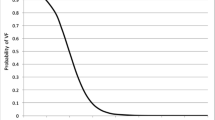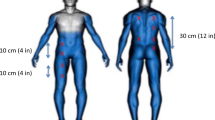Abstract
Arrest-related deaths proximate to the use of a conducted electrical weapon (CEW) continue to generate controversy despite a better understanding of the multi-factorial nature of many of these deaths. With the rapid adoption of this technology by law enforcement, and the proliferation of companies entering the marketplace, it is important to have a method to assess the relative safety of these weapons. We had previously developed a model to assess the relative cardiac safety of CEWs. In this study, we use this model to compare the TASER X2 and the Karbon Arms MPID. Our results suggest that the TASER X2 may have an improved cardiac safety margin over the Karbon Arms MPID as determined by a smaller area of cardiac pacing on the anterior chest in our model. This model seems to offer a reproducible means of comparing the cardiac effects of CEWs.




Similar content being viewed by others
References
Dennis A, Valentino D, Walter R, Nagy K, Winners J, Bokhari F, Wiley D, Joseph K, Roberts R. Acute effects of TASER X26 discharges in a swine model. J Trauma. 2007;63:581–90.
Valentino D, Walter R, Dennis A, Margeta B, Starr F, Nagy K, Bokhari F, Wiley D, Jospeh K, Roberts R. TASER X26 discharges in swine: ventricular rhythm capture is dependent on discharge vector. J Trauma. 2008;65:1478–87.
Nanthakumar K, Billingsley I, Masse S, Dorian P, Cameron D, Chauhan V, Downar E, Sevaptsidis E. Cardiac electrophysiological consequences of neuromuscular incapacitating device discharges. J Am Coll Cardiol. 2006;48(4):798–804.
Lakkireddy D, Wallick D, Verma A, Ryschon K, Kowalewski W, Wazni O, Butany J, Martin D, Tchou P. Cardiac effects of electrical stun guns: does position of barbs contact make a difference? PACE. 2008;31:398–408.
Ho JD, Dawes DM, Reardon RF, Strote SR, Kunz SN, Nelson RS, Lundin EJ, Orozco BS, Miner JR. Human cardiovascular effects of a new generation conducted electrical weapon. Forensic Sci Int. 2011;204(1–3):50–7.
Zipes D. Sudden cardiac arrest and death following application of shocks from a TASER electronic control device. Circulation. 2012;125:2417–22.
Kroll M, Lakkireddy D, Stone J, Luceri R. TASER electronic control devices and cardiac arrest: coincidental or causal? Circulation. 2014;129:93–100.
Zipes D. Can TASER electronic control devices cause cardiac arrest? Circulation. 2014;129:101–11.
Hamlin RL, Burton RR, Leverett SD, Burns JW. Ventricular activation process in minipigs. J Electrocardiol. 1975;8(2):113–6.
Kano M, Toyoshi T, Iwasaki S, Kato M, Shimizu M, Ota T. QT PRODACT: usability of miniature pigs in safety pharmacology studies: assessment for drug-induced QT interval prolongation. J Pharmacol Sci. 2005;99(5):501–11.
Crick SJ, Sheppard MN, Ho SY, Anderson RH. Localization and quantitation of autonomic innervation in the porcine heart I: conduction system. J Anat. 1999;195(Pt 3):341–57.
Dawes D, Ho J, Moore J, Miner J. An evaluation of two conducted electrical weapons and two probe designs using a swine comparative cardiac safety model. Forensic Sci Med Pathol. 2013;9(3):333–42.
Khaja A, Govindarajan G, McDaniel W, Flaker G. Cardiac safety of conducted electrical devices and their effect on pacemaker function. Am J Emerg Med. 2011;29(9):1089–96.
Rahko P. Evaluation of the skin-to-heart distance in the standing adult by two-dimensional echocardiography. J Am Soc Echocardio. 2008;21:761–4.
Wu J-Y, Sun H, O’Rourke A, Huebner S, Rahko J, Webster J. Taser blunt probe dart-to-heart distance causing ventricular fibrillation in pigs. IEEE Trans Biomedical Eng. 2008;55(12):2768–71.
TASER International v. Karbon Arms, LLC. U.S. District Ct., DE; 2014.
Beason C, Jauchem J, Clark CD, Parker J, Fines D. Pulse variations of a conducted energy weapon (similar to the TASER X26 device): effects on muscle contraction and threshold for ventricular fibrillation. J Forensic Sci. 2009;54(5):1113–8.
Ho J, Dawes D, Miner J, Kunz S, Nelson R, Sweeney J. Conducted electrical incapacitation during a goal-directed task as a function of probe spread. Forensic Sci Med Pathol. 2012;8(4):358–66.
Mesloh C, Henych M, Thompson Wolf RF. Qualitative and quantitative analysis of conducted energy devices: TASER X26 v Stinger S200. A Report to the NIJ. 2008;1–116.
Bozeman WP, Hauda WE 2nd, Heck JJ, Graham DD Jr, Martin BP, Winslow JE. Safety and injury profile of conducted electrical weapons used by law enforcement officers against criminal suspects. Ann Emerg Med. 2009;53(4):480–9.
Strote J, Walsh M, Angelidis M, Basta A, Hutson HR. Conducted electrical weapon use by law enforcement: an evaluation of safety and injury. J Trauma. 2010;68(5):1239–46.
Conflict of interest
TASER International, Inc. provided funding and material support for this study. Dr. Ho is the medical director for TASER. Dr. Dawes is a consultant to TASER. Drs. Ho and Dawes own shares of stock in the company. Drs. Moore, Laudenbach, Reardon, and Miner have no conflicts to declare.
Author information
Authors and Affiliations
Corresponding author
Rights and permissions
About this article
Cite this article
Dawes, D.M., Ho, J.D., Moore, J.C. et al. An evaluation of two conducted electrical weapons using a swine comparative cardiac safety model. Forensic Sci Med Pathol 10, 329–335 (2014). https://doi.org/10.1007/s12024-014-9577-0
Accepted:
Published:
Issue Date:
DOI: https://doi.org/10.1007/s12024-014-9577-0




